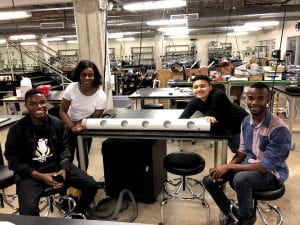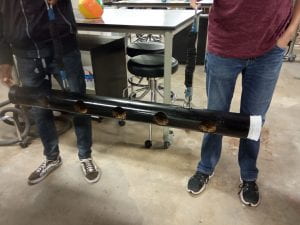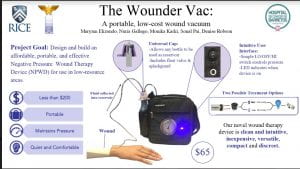Having finished our Pugh screening/scoring, we proceeded to develop our final solution for the red river hog puzzle feeder. After evaluating the cost, potential durability and ease of maintenance of our various proposed solutions, we realized that our best option was the so called “PVC dig”. This design would simulate the hog’s “digging for food” experience by allowing it to look for food pellets in a PVC pipe with small holes. The hog would put its legs/snout into the tube and pull the food out manually. This solution was deemed to be easy to clean, durable, and likely to extend feeding time for the zoo’s hog.
The rest of Monday was spent manufacturing the solution, and on Tuesday we evaluated the solution against a number of tests. These tests were designed to evaluate the solution against our original design criteria. For example, in order to test for durability, we dropped the device 40 times from a height of 4 ft. We then checked for cracks, ruptures, and sharp edges throughout the device. Our device passed all our tests! We hope the Houston Zoo is able to implement it successfully.
On Wednesday we were introduced to our team projects for the remainder of the summer. Novath, Alexander, Nneoma and I took on the “wounder women” project. The project seems really interesting. The goal is to develop a device that can recreate negative pressure wound therapy (NPWT) at a low cost.
NPWT involves placing a sponge and dressing on a wound. The sponge is then connected to a pump via some tubing. The tubing itself connects to a reservoir and this reservoir stores any blood or waste fluids that are absorbed by the tubes. The application of negative pressure increases blood flow to the wound site and encourages more rapid repair. This prevents necrosis and allows the patient to recuperate more rapidly.
However, NPWT devices are rarely portable, and those that can be carried by one individual often cost in the thousands of dollars. This makes NPWT inaccessible to low income patients. The wounder women managed to create a prototype that contains the main features of a NPWT device at a cost of less than 100 USD. Our goal is continue their work, and make a viable final prototype.
After being assigned the project we had to tackle a very important issue: come up with a team name. After considering more than 40 potential names, holding various elections with various voting systems, debating whether we should develop design criteria for the team name, and more voting, we settled on “iwound”. We liked the ironic feel of it, and since our work was going to focus on redesigning the electronic components of the current design, we thought the name was informative and relevant.
Despite our struggles, the hard work had not begun. We spent the rest of the day reading through Wounder Women’s project documentation. This allowed us to understand the limitations of their prototype, their project goals, and the rationale behind their decision making process. This was particularly helpful when we talked to Dr. Abadi (our main contact for the project). From her we learned that our top priority should be in ensuring that the pressure being delivered by the pump is consistent throughout the tubing, and high enough to actually facilitate NPWT. In addition, we should also improve the electronics of the device and develop a better user interface.
Once we developed a solid background on NPWT, we decided to break up the extensive research we would need to undertake. Throughout the next couple of days I will be focusing on understanding the fluid mechanics and plumbing of the NPWT device. The learning curve seems steep, but I look forward to it. I guess we’ll see how things flow.



